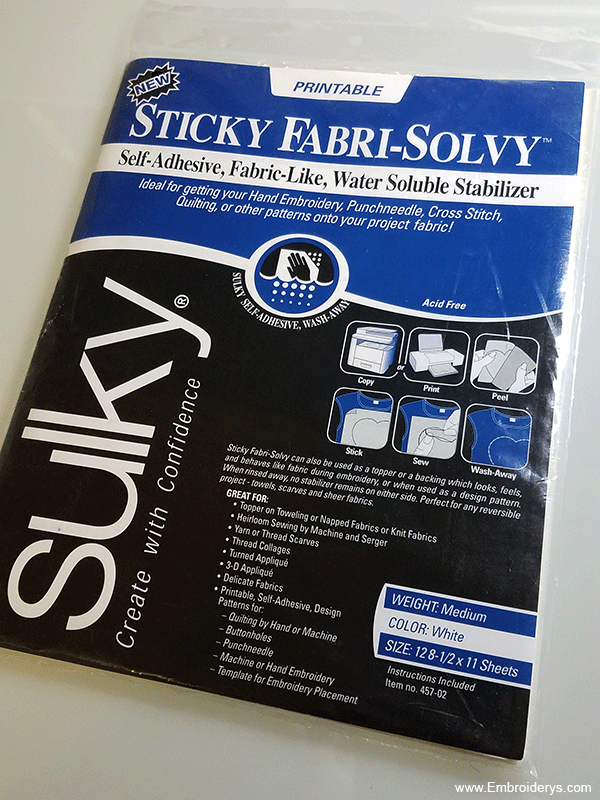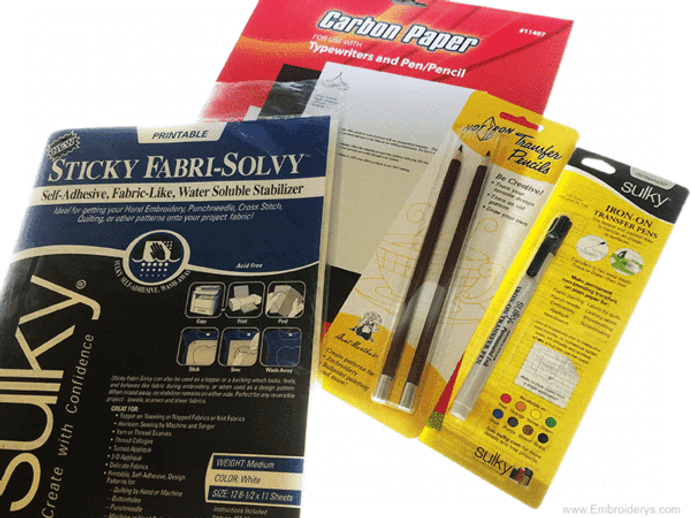4 Easy Ways You Can Transfer Your Hand Embroidery Patterns!
Hand embroidery today is more popular than ever! With the ability to download a digital file of a pattern, you can print it out and then start stitching in no time at all! This only makes creative hand projects such as ours that much more easy and fun!
For some though, the idea of transferring an embroidered pattern might seem a bit problematic or difficult. Thankfully there are a number of easy techniques listed below that work quite well, and don’t require any elaborate tools on your part.
CHOICE 1 - Transferring Patterns Using Heat Transfer Pens and Pencils - Pricing: $
The use of heat transfer pens and pencils can be used in two different ways. First, if your pattern has the ability to be printed in reverse, you can then trace directly on the lines of the pattern with a heat transfer pencil or pen. Simply place the fabric face down and heat with the an iron to transfer. The pattern will transfer to the fabric after the steady use of applying heat to the application. The second option is that you can also flip the paper over, then trace the design onto the back side of the paper using a heat transfer pencil or pen, pressing the design onto the fabric much like a ready-made iron-on transfer.
CHOICE 2 - Transfer Patterns With Carbon Paper - Pricing: $$

Carbon paper has been around since the typewriter and is probably one of the more 'seasoned' ways to transfer a myraid of type, text and images from one medium to another. Carbon transfer paper is available at most fabric and craft stores and is also easily obtainable online. One side is typically colored, while the other side is blank. First, place the colored carbon side of the transfer paper on the fabric, then place the pattern face up over that. You can then use a ballpoint pen to trace each line in order to transfer to the fabric. You may have to go over the lines more than once to get a solid mark on the fabric, but also be careful not to apply too much pressure, because the pen can push through the paper and potentially mark or stain the fabric.
CHOICE 3 - Transfer Patterns Using Fabric-Solvy Pattern Transfer Paper - Pricing: $$
This is a newer item on the market that a few embroiderers like to employ. Instead of printing onto a regular sheet of laser paper, you can also run this material directly through a computer printer. You then adhere it directly to the fabric, stitch over it and later, have it dissolve away when submerged in water. This is a terrifically easy and fun technique that provides a completed transfer of each pattern line. However, using this 'paper' for all your embroidery projects can get a little pricey as it is generally more costly than plain laser paper. Pre-cut 8 1/2 by 11 sheets usually will come in packs of 12, however you can also buy these in rolls (you will then have to cut these by hand if you intend to run them through your printer)
CHOICE 4 - Transfer Patterns Using a Backlight - Pricing: Free-$$$ (One Time Cost)
Another option, and Tattered Stitch's preferred method of transferring an embroidery pattern, is by use of a back-light or what is commonly referred to as a light table or light box. This technique allows a person to trace a pattern very easily and has the added benefit of providing a stable work surface to trace on. A water-soluble pen works well for transferring patterns using such a light. It is recommended that you tape the pattern to the light box, then tape the pattern over that. Finally use a water-soluble pen for transferring each pattern line.
If you are feeling extra frugal, you can also simply use a bright window that receives a good amount of sunlight. Tape yourr pattern to the window, then tape your fabric over that. The light will shine through and you can trace over each pattern line in order to transfer to the fabric. The only downside for this option is that you are limited to the use of daylight hours only.
Stay tuned for more insightful articles at Tattered Stitch Embroideries!
Price Reference Guide
$ - Under $10 US
$$ - $10-$20 US
$$$ - Over $20+ US
Recent Posts
-
Hurricane Helene Fundraiser - Lets Help
Hurricane Helene - Lets Help Hi all, it has been a while since we have done a fundraiser and with …Oct 4th 2024 -
The Four Basic Types of Stabilizers!
The Four Basic Types of Stabilizers!Check out how they are used via our infographic below. …Sep 23rd 2024 -
Our 5 Most Popular Projects! - Tattered Stitch Embroideries
Want to view some of our most popular in-the-hoop designs? Look no further!...Placemats - https://ww …Dec 14th 2023




